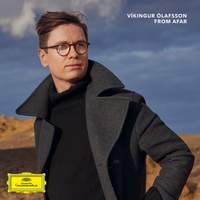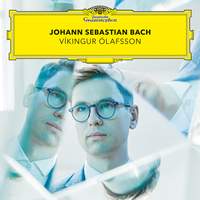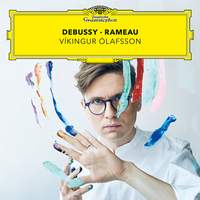Interview,
Víkingur Ólafsson on From Afar
 Following his widely acclaimed albums devoted to the music of Philip Glass, JS Bach, Debussy/Rameau and Mozart & his Contemporaries, the Icelandic pianist Víkingur Ólafsson's latest project for Deutsche Grammophon is a rather more eclectic and personal affair, linking together works which have played a central role in his own development as an artist as well as having a special significance for one of his musical heroes - the Hungarian composer and pianist György Kurtág, whose work Ólafsson first encountered as a teenager thanks to his father's passion for contemporary music.
Following his widely acclaimed albums devoted to the music of Philip Glass, JS Bach, Debussy/Rameau and Mozart & his Contemporaries, the Icelandic pianist Víkingur Ólafsson's latest project for Deutsche Grammophon is a rather more eclectic and personal affair, linking together works which have played a central role in his own development as an artist as well as having a special significance for one of his musical heroes - the Hungarian composer and pianist György Kurtág, whose work Ólafsson first encountered as a teenager thanks to his father's passion for contemporary music.
Vikingur spoke to me from his practice-room at home in Iceland last month about how receiving a 'mysterious message' from Kurtág's team whilst en route to a concert last summer led to a three-hour meeting of minds in Budapest, and how the conversation inspired him to create this musical 'fan-letter' to the 96-year-old composer - including a note of greeting from Thomas Adès in the form of The Branch, which was penned especially for the album and receives its world premiere recording here...
How far back does your relationship with Kurtág extend?
Until last summer I didn’t know he had any idea of my humble little existence! I have a respect for him that’s almost dangerously high - I’m not shy with many people, but meeting Kurtág was like meeting someone like Bartók. He’s a living legend, and at 96 he’s still producing fantastic music: it’s kind of beautiful because he’s a late bloomer as a composer, and in the second half of his life he’s written so many things that are already absolute classics of the repertoire.
I was introduced to his music in my teens by my father, who did regular programmes about Kurtág for Icelandic radio in the 1990s. My dad was a composer and architect, and he’d sit listening to all sorts of wacky contemporary music while designing houses: Kurtág was a favourite, so he made me listen to stuff like the Kafka-Fragmente when I was about fifteen! I didn’t get it like I do today, but I was fascinated by it. Sometimes he’s so daringly minimal and that’s what I chose for this album, because I thought it would work beautifully with some of Kurtág’s heroes like Bach and Schumann - composers he’s honoured with numerous transcriptions and homages.
So how did your meeting last summer come about?
I was travelling to Budapest to give a Mozart recital when I got this mysterious message from his team: ‘Mr Kurtág would like to meet you – please come to the Budapest Music Centre where he lives…’. I was flying overnight from California, along with another amazing composer, John Adams: it was very interesting to go from John to Kurtág, because they’re both incredible musicians in such different ways.
When I arrived Kurtág told me that he and his late wife Márta had been following my work since I joined Deutsche Grammophon, and specifically since the Bach recording - and what was supposed to be a quick visit turned into three hours! There were two grand pianos there, one of which had belonged to Márta, and I played whatever came to mind on each: Bach, Haydn, Mozart, Schumann, Galuppi, the two Icelandic songs that ended up on the album, and some Bartók. (None of his own music: I was too nervous!). Kurtág has famously critical ears, but there was no sense of him being in teaching mode: the only thing he asked me to do differently was to add one little accent in a Mozart gigue, so I got off pretty well!
The Bartók moment was my happiest: I’ve loved his music my whole life, and Kurtág said to me ‘You play Bartók like it’s your Mutterzunge’. Coming from him that was a huge confidence-boost, because my Bartók’s slightly different from the way most people play it: I like to focus on the vocal and the lyrical side and the colours. Back in 2002 I had a lesson with György Sándor, who was a student of Bartók, and I remember him saying that Bartók himself had always emphasised those aspects of his music rather than the percussive in his own recordings.
I feel the same about Kurtág, because he’s so obviously in that same tradition: there’s this line in music history that flows from Bach through Schumann to Bartók, and Kurtág is the continuation of that river.
How did you go about distilling that encounter into an album?
I see this album as two things: first of all it’s a fan-letter to Kurtág, expressing my admiration and trying to connect his musical aesthetics with the musical aesthetics of some of his heroes. (I couldn’t find the right words to write him a proper letter, so an album has to do!). But it’s also a potted autobiography, bringing together some of the composers and works that have been at the core of my musical life so far: it’s my way of telling Kurtág (and my other listeners) a bit more about where I come from and who I am.
Folksong is also a theme, as I was keen to connect the Bartók folksongs with my favourite Icelandic one. Kurtág himself said to me that there are similarities between all folk-songs: hundreds of years of human experience are accumulated in these works, and because they go back so many generations the lines between different cultures and ethnicities become fainter and fainter. It’s a bit like language – you and I used to speak the same language, Katherine! English has altered beyond recognition over the centuries but Icelandic hasn’t changed that much over time, because it was an island where no-one came for a thousand years!
That’s partly why I wanted to bring in this beautiful Icelandic Ave Maria by Sigvaldi Kaldalóns, which is a favourite piece of mine. It was also the first transcription I ever did, back in 2007, which I dedicated to my wife when we were first dating: it’s just a personal little thing, but it was lovely to go through my chest of drawers and pull out pieces that wouldn’t fit naturally on a more conventional album.
And your wife makes an appearance on several tracks...
Yes. The idea of canon is such a beautiful a thing to me, and there are lots of them on the album: I think of it like a dialogue of two people, even a metaphor for marriage. Kurtág used to play with Márta, who had this affinity for me even though I never met her – and that’s why my wife is also playing with me here. If I say so myself, she plays incredibly well: she used to be a pianist and then she studied something else in Oxford. Now we have two boys aged 1 and 3 so she doesn’t travel much with me for now, but she joins me here for the Bach trio sonata that Kurtág transcribed for three hands. He dedicated that to me a month ago, which is so sweet!
(Kurtág called me three weeks ago, very happy about the album, but very unhappy that there was no photo of Halla in the booklet: ‘Let me give you advice – I have nearly a century of experience with marriage, and it is very important that you don’t neglect your wife like this!’).
You mentioned 'conventional' albums earlier - are there any connections back to your previous composer-based projects?
Yes - my idea was to combine that Icelandic Ave Maria with the Mozart Laudate Dominum (my biggest transcription arrangement to date), and to bring a new little Bach transcription from the Solo Violin Sonata No. 3… and the weirdest thing is that Kurtág has just transcribed a movement from that same sonata himself. It’s quite uncanny, but we do seem to be on the same wavelength: there are about a thousand Bach pieces to choose from and we randomly hit on the same one!
When we met up I played him my transcription of the Adagio from the Mozart G minor Quintet [K516]: it’s my favourite movement, and I had no idea it was also his favourite. In fact he and Márta [who died in 2019] chose it when they were planning her funeral, along with the Cavatina from Beethoven’s String Quartet Op. 130 and Ligeti’s Poème Symphonique for 100 Metronomes.
What's the story behind the commission from Thomas Adès?
Tom wrote it especially for the album, and as yet I’ve never played it live. It’s called The Branch and it’s inspired by a Hungarian poem – it’s Tom’s own greeting to Kurtág, whom he loves and I think studied with at one point. The two of us were catching up over a post-concert drink back in March, and I told Tom what I just told you: that I was having a hard time finding the words to write to Kurtág so instead I was recording an album shortly…Tom said ‘OK, let me write you a little piece as my greeting, because I have the same problem! I wish I was like Steven Isserlis who just calls him up for a chat!’.
Tom is obviously on the same level as Kurtág as a composer, and it’s such a beautiful homage from one absolute master to another – how lucky am I to have both of them in my musical life? Adès and Kurtág: those names are going to go down in music history like Ravel and Prokofiev, and it’s a huge honour to have brought them together. If I achieve nothing else, at least I did that!
You've chosen to record the album twice, once on an upright and once on a grand - tell me a little about the two pianos in your early life...
That’s been such a focus-point in the publicity, but it came about so naturally that I almost forget to mention it! I grew up in a household dominated by a Steinway grand, which sounds like we were super-rich but we certainly weren’t! My parents spent all their savings and took out a loan to buy it before they even bought our tiny apartment: I shared a bedroom with my two sisters until I was seven, and the piano took up our whole living-area.
When we moved to a slightly bigger place I got my own bedroom, but the grand piano was very often occupied – my mother would teach on it during the day and my father would compose on it in the evenings, so their solution was to get this very old, fragile Danish piano for my room. It was pretty beaten up but I came to love that sound, and also the act of just closing the door and having this very small studio for myself.
I had two grand pianos in the studio for this album, then I thought it might be nice to have some extra material on the upright, inspired by the fact that Kurtág loves it: he recorded much of his piano work in the last twenty or thirty years (including the recordings with Márta) on an upright with a super-soft set-up.
I started to play around on the upright and loved it – it fits so well with Kurtág’s music, and the palette between pp and ppp and pppp (a dynamic range which he uses a lot) is so special. It’s nice for people to have that option, especially when they’re listening on headphones: inevitably some critics will think I’ve dumbed it down by bringing in a ‘pub’ piano, but that’s not true. This kind of piano gets used a lot in Hollywood and in the neo-classical world in a slightly cheap way, but that was Kurtág’s sound long before it was appropriated by Hollywood. I ended up recording the entire album twice, and then I didn’t want to choose between my two children!
So much changes when you play this music on an upright: the grand has much bigger sustain, which affects your timings and phrasing and entire approach. There are some tracks I certainly do prefer on a grand – my favourite Brahms Intermezzo is just amazing on a Steinway - but things like Kurtág’s Sleepily are so strangely beautiful on an upright, with all those glissandos and tone-clusters. And when you listen to the upright recording it feels like you’re sitting on the piano bench, because you hear my breathing and all those extra noises from the piano: it’s very imperfect in that sense, but also very human.
Finally, where was that stunning publicity-video filmed?
It’s on the South-West peninsula of Iceland, between Keflavík airport and Reykjavík itself – about 25 minutes’ drive from my house. And it’s such a surreally beautiful place, with so many wonderful colours and steam coming from the ground. You feel like you’re on Mars, and in fact it’s where they used to take the American astronauts to train them for the moon landings! The title From Afar comes from one of Kurtág’s pieces - but it’s also my way of saying ‘this is where I come from’, and I think the cover captures that perfectly.
Víkingur Ólafsson (piano); also featuring Halla Oddný Magnúsdóttir (piano)
Available Formats: 2 CDs, MP3, FLAC, Hi-Res FLAC, Hi-Res+ FLAC
Other recordings by Víkingur Ólafsson
'I expected this to be good; but just how good it was was still a surprise…Ólafsson creates a ravishing musical sequence. Every track has its own allure, and many reflect a virtuosity which is never flaunted.' (BBC Music Magazine - Recording of the Year, 2019)
Available Formats: CD, MP3, FLAC, Hi-Res FLAC
'He asks how to “deal” with Mozart: easy on first glance, but elusive and difficult once you dig deeper…His clear, agile playing, inner parts brought out, ornaments always fresh, never exaggerated, suggests he has found peace with the composer. This is just the start.' (The Guardian)
Available Formats: CD, MP3, FLAC, Hi-Res FLAC, Hi-Res+ FLAC
'In Ólafsson’s hands these pictures and sensations, transmuted into music, radiate with lightness, elegance, and a delight in every variety of life. Key to this success is his fingering, always sensitive and crisp...It’s like riding a magic carpet, and I didn’t want the journey to end.' (The Times - Records of the Year 2020)
Available Formats: CD, MP3, FLAC, Hi-Res FLAC, Hi-Res+ FLAC
'Olafsson’s recording of 10 [piano études], rich with interpretive depth and surprising turns, is nothing short of eye-opening.' (The New York Times - Recording of the Year, 2017)
Available Formats: CD, MP3, FLAC, Hi-Res FLAC







